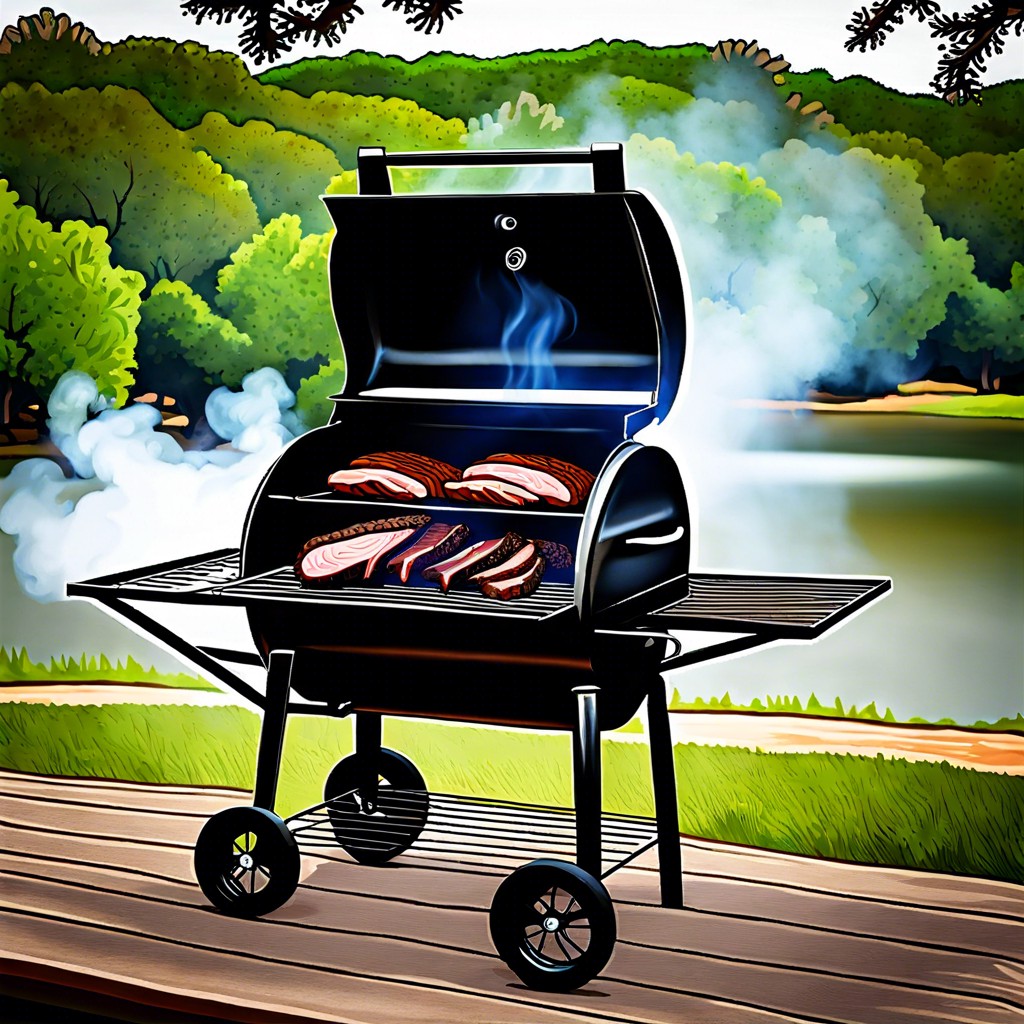While opinions on which state has the best BBQ can be as varied as the styles themselves, we will examine the characteristics and traditions that distinguish the leading contenders for the title.
Key takeaways:
- Central Texas: Brisket and Post Oak
- Kansas City: Burnt Ends and Sauce Variety
- Memphis: Dry Rubs and Wet Ribs
- Criteria for Evaluating State BBQ: Meat, Technique, Sauce, and Sides
- Cultural Significance and Tradition in State BBQ Styles
Central Texas: Brisket and Post Oak

At the heart of Central Texas barbecue is the brisket, a cut demanding reverence for its low and slow cooking process. This technique coaxes out a melt-in-your-mouth tenderness that’s become the gold standard for this regional specialty. Marbling is key; it allows the fat to render beautifully throughout the long smoking period, imparting moisture and flavor.
The wood of choice here is post oak, celebrated for its subtle, smoky essence. Its use ensures the meat, rather than the smoke, remains the star. Unlike its Southern counterparts, this region shuns heavily sauced meats. Instead, a simple salt and pepper rub prevails, honoring the quality of the beef and the precision of the smoking process. This minimalist approach spotlights the true skill of the pitmaster and the natural taste of the beef.
Central Texas sides often play a supporting role – think white bread, pickles, and onions – to keep the focus firmly on the prized brisket. This is barbecue at its most elemental, where simplicity underscores complexity, and every bite is redolent of tradition.
Kansas City: Burnt Ends and Sauce Variety
Kansas City stakes its claim on the map of great American BBQ with its signature burnt ends—crispy, fatty, bite-sized pieces from the point end of the brisket. These morsels have ascended from a pitmaster’s snack to a coveted barbecue delicacy, offering a rich, smoky flavor that is synonymous with this region’s love affair with beef.
The array of sauces is another defining characteristic, from sweet to tangy to spicy, creating a mosaic that caters to a range of palates. Unlike other regions where sauce is ancillary, here it’s central to the experience, with many establishments boasting secret recipes that have been refined over generations. Side dishes, too, play a substantial role, with a strong emphasis on classics such as creamy coleslaw and smoky pit beans that stand up to the bold flavors of the meats.
The preparation process respects the low-and-slow cooking tradition, with a slight twist—oak and hickory wood are often used, imparting a distinctive smoke that gently permeates the meat. Kansas City BBQ is about balance and contrast: the texture of bark against succulent meat, and the interplay of smoke and sauce. These elements combine to create a diverse and indulgent barbecue experience.
Memphis: Dry Rubs and Wet Ribs
In Memphis, the dry rub is a defining feature of their barbecue style, consisting of a blend of spices—typically paprika, garlic powder, onions, cumin, and other regional spices. Applied liberally, these rubs create a flavorful crust that is both savory and nuanced, locking in the meat’s juices and elevating the texture.
Unlike their sauce-soaked counterparts, these rubs enable the natural flavors of the pork to shine without overwhelming the palate with sweetness or tang.
Conversely, when Memphis does wet ribs, they do so with a meticulous approach. Basted with sauce during the last minutes of cooking, these ribs emerge with a glistening, sticky coating that complements rather than dominates. The sauce, often tomato-based with a balance of vinegar and sweetness, penetrates the exterior, creating a succulent bite that melds the smokiness of the meat with the complexity of the sauce.
Moreover, this duality of Memphis barbecue allows for a diverse exploration of flavors within the same tradition, showcasing the versatility of their approach to smoked meats. Whether dry or wet, the pork ribs remain at the epicenter of Memphis barbecue, a testament to the city’s dedication to their craft.
Criteria for Evaluating State BBQ: Meat, Technique, Sauce, and Sides
When determining the apex of state BBQ, consider these core elements:
- Meat: Quality cuts are the foundation. Beef brisket reigns in Texas, while pulled pork takes the spotlight in the Carolinas. The prime selection sets the stage for BBQ excellence.
- Technique: Mastery over fire and smoke transforms the ordinary into the extraordinary. Low and slow defines the game, but the devil is in the details—temperature control and timing can make or break the meal.
- Sauce: Whether a tangy vinegar base or a rich, molasses-infused concoction, sauce can amplify or overshadow the meat’s natural flavors. A balanced sauce complements without dominating.
- Sides: Often seen as mere accompaniments, sides like coleslaw, beans, and cornbread play critical roles in rounding out the BBQ experience. They should harmonize with the main course, adding contrast and enhancing the overall palate.
Cultural Significance and Tradition in State BBQ Styles
BBQ is deeply entwined with regional identity, acting as a reflection of history and community values. Pitmasters pass down techniques through generations, preserving a culinary narrative that often dates back to indigenous cooking practices and immigrant influences.
In Texas, smoking meat was a method to tenderize tough cuts, a practice brought by German and Czech settlers.
In North Carolina, the tradition of whole-hog barbecuing has roots in Native American cooking styles.
The use of dry rubs in Memphis emerged from a history of spice trading along the Mississippi River.
Missouri’s Kansas City is a melting pot of BBQ methods, stemming from its historical role as a hub for livestock processing.
This heritage is celebrated at competitions, festivals, and family gatherings, where BBQ is not just food, but a medium of storytelling and communal connection.